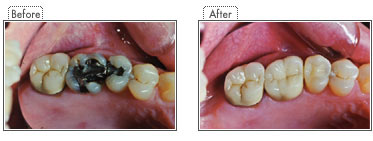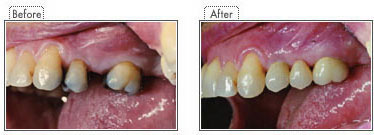|
|
|
| |
 |
 |
  |
 |
|
 |
| |
|
|
| |
Smile Design
Orthodontics is the art of aligning the teeth and jaws to improve
the patient 's smile and oral health. It is recommended that
a child be seen by an orthodontist early on so as to form a
baseline on development of the child’s arch and jaw. If
braces are needed, placement usually occurs between ten and
fourteen years old. The reason for this age is due to the fact
that the mouth and head are still growing. Braces are worn depending
on each individual case. The average length of time is between
eighteen and thirty months which is followed by wearing a retainer
for a few months to allow the tissues and bones to form around
new tooth position. With braces, oral hygiene is more important
than ever before. Due to the appliances and tiny spaces that
they contain, food and plaque get trapped. Decalcification and
cavities can form quickly so children must brush more often.
The use of fluoride toothpastes and rinses are also recommended
to protect the teeth.

Porcelain Veneers
Veneers are porcelain wafers that are laboratory fabricated
and are bonded onto the tooth. They are highly esthetic and
lifelike. They are designed to correct colors, sizes,
shapes, spaces and alignments of teeth. They are stronger
and more durable than composites.

All Ceramic Crowns
Procedure whereby a tooth is covered to strengthen a damaged
tooth. The tooth may have been damaged by decay, or have a previous
restoration that has fractured. Root canaled teeth are also
crowned if sufficient tooth is missing or if the dentist feels
that the tooth will last longer by protecting it with the crown.
There are several types of crowns. The dentist and patient will
make the decision as to which one is best for patient. This
involves several phases. One in which the dentist prepares the
tooth and a temporary is fabricated and used to temporize the
tooth while the crown is being processed in a dental laboratory.
The second step is inserting the permanent crown. Failing to
return to have the permanent crown placed can cause damage to
the underlying tooth due to weakness and poor fit of the temporary
crown.



Bridges
A dental bridge is a false tooth, known as a pontic, which is
fused between two porcelain crowns to fill in the area left
by a missing tooth. The two crowns holding it in place that
are attached onto your teeth on each side of the false tooth.
This is known as a fixed bridge. This procedure is used to replace
one or more missing teeth. Fixed bridges cannot be taken out
of your mouth as you might do with removable partial dentures.
In areas of your mouth that are under less stress, such as your
front teeth, a cantilever bridge may be used. Cantilever bridges
are used when there are teeth on only one side of the open space.
Bridges can reduce your risk of gum disease, help correct some
bite issues and even improve your speech. Bridges require your
commitment to serious oral hygiene, but will last as many ten
years or more.


Tooth Colored Filling
Tooth colored fillings are also referred to as composites, because
they are composed of a complex composite of plastic and zirconia/silica.
Composites were introduced in the 1960’s, and have undergone
continual improvements in durability, color stability, material
handling qualities, and esthetics.
Fillings are considered one type of tooth restoration. Other
restorations include inlays , onlay, veneers and crowns .
Tooth colored fillings are actually bonded to teeth compared
to silver / amalgam fillings, which are not.

Bonding
A procedure whereby the dentist uses special dental adhesives
between tooth surface and another material. The tooth is first
chemically treated with a special dental acid which causes microscopic
porosites in the enamel. The adhesives form a bond with the
bonding material. These materials come in various colors and
shades. There are also flowable and dough-like materials. The
dentist chooses the one he feels best suits theprocedure he
is performing. The materials at present are highly polishable,
are very strong and most last quite a long time. Some even contain
fluoride which aids in preventing new cavities from forming.
Bonding uses include restoring chips, filling holes, spaces
or discolorations.

Implant
Dental implants are designed to provide the foundation for the
restorative dentist to replace missing teeth to form and function.
The patient has the ability to eat virtually anything. Facial
contours and tooth space is also maintained by replacing missing
teeth. Implants are fabricated of titanium posts which are inserted
into the jaw bone where the teeth are missing.
There are many different types of implants and the determination
is made on examination and the degree of space, amount of remaining
bone and individual choice of dentist. Once the implant is placed,
a healing time is needed, which may take six months. Once the
implant is ready, it acts as if it were a tooth root substitute,
where the dentist can now perform his restorative treatment.

Root Canals
A root canal is needed when the pulp or nerve of a tooth gets
affected by decay or trauma. The blood flow within the tooth
rushes to the site of inflammation in order to aid the tooth,
but what occurs as a result is a pressure on the nerve endings
which generates the pain response. Pain usually occurs at night
or when lying down, can be triggered by hot or cold and can
be occasional or continuous. What occurs is a slow progression
whereby decay may invade the pulp space and travel through the
canal and settle at the end of the root. What occurs is an abscess
or swelling at this site. Other causes of nerve pain can be
fractures of teeth, large fillings that are not tolerated by
the pulp or constant trauma to the tooth. Occasionally, it is
difficult to diagnose which tooth may be the culprit until localization
occurs.
Treatment involves cleaning the canal space by removing the
infected or affected nerve, washing the space and filling the
space with an inert, rubber-like material that helps seal the
space. Bio-compatible cements are used with this material to
seal any smaller openings. As with any procedure, success or
failure of a procedure depends on the circumstances, infection
and patient. These can be discussed with the individual dentist.
After endodontic therapy, the patient returns to the dentist
to restore the tooth.

Teeth Whitening
Sometimes a single tooth becomes discolored causing it to look
out of place with the rest of your smile. In these cases you
may want to consider having the tooth whitened to match the
rest of your teeth. If you'd like to learn more about what causes
the discoloration and what can be done about it, please follow
the links below.

Childern Dentistry
Our office recommends that the first "regular" dental
visit be just after your child's third birthday. No child is
“too young” for a first dental visit if you see a
problem or have a question.
At your child’s first routine examination we will gently
examine his or her teeth and gums. X-rays may be taken in order
to reveal any decay and check on the progress of the teeth that
are still forming. We may also clean his or her teeth and apply
topical fluoride to help protect against decay.
If you are not from an area with fluoridated water, we will
discuss prescription supplements. Most important of all, we
will review with you what you can do at home to care for your
child’s teeth.

Denture
This is a removable appliance that is custom fabricated for
the patient to replace missing teeth. The materials used are
made of acrylic resins alone or in conjunction with various
metals. A partial denture replaces some teeth where the patient
has some remaining permanent teeth. A complete or full denture
replaces all teeth. An immediate denture , whether complete
or partial, involves placing the appliance the same day the
teeth are removed.

|
|
|